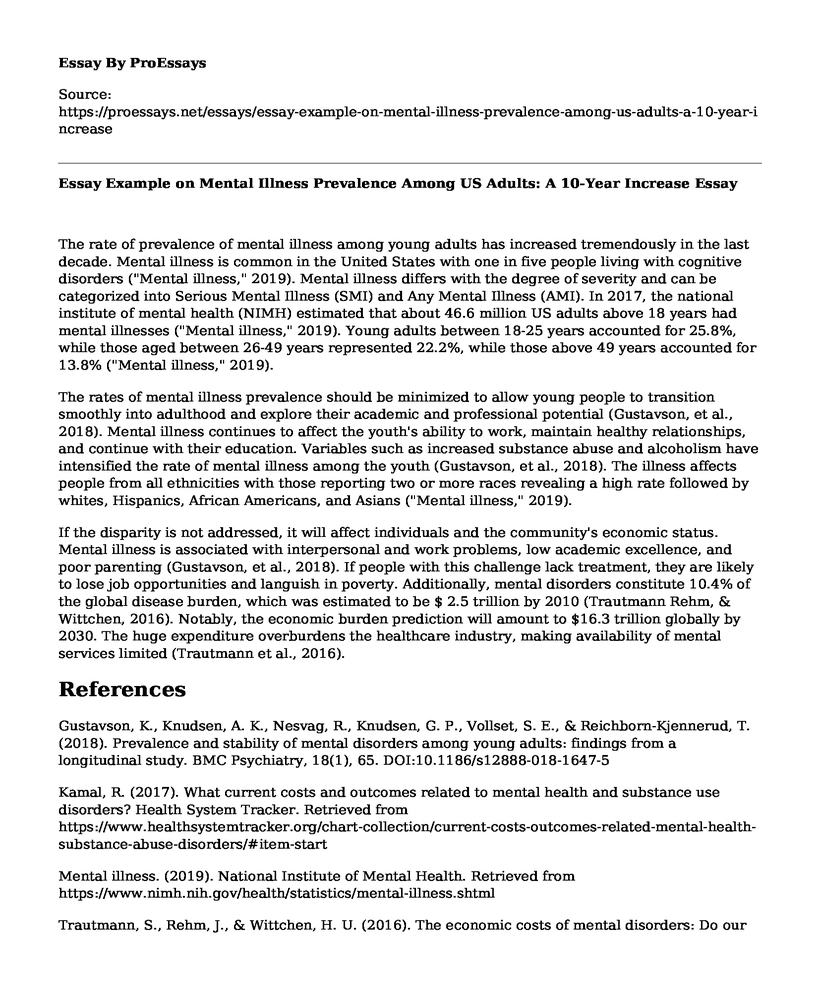The rate of prevalence of mental illness among young adults has increased tremendously in the last decade. Mental illness is common in the United States with one in five people living with cognitive disorders ("Mental illness," 2019). Mental illness differs with the degree of severity and can be categorized into Serious Mental Illness (SMI) and Any Mental Illness (AMI). In 2017, the national institute of mental health (NIMH) estimated that about 46.6 million US adults above 18 years had mental illnesses ("Mental illness," 2019). Young adults between 18-25 years accounted for 25.8%, while those aged between 26-49 years represented 22.2%, while those above 49 years accounted for 13.8% ("Mental illness," 2019).
The rates of mental illness prevalence should be minimized to allow young people to transition smoothly into adulthood and explore their academic and professional potential (Gustavson, et al., 2018). Mental illness continues to affect the youth's ability to work, maintain healthy relationships, and continue with their education. Variables such as increased substance abuse and alcoholism have intensified the rate of mental illness among the youth (Gustavson, et al., 2018). The illness affects people from all ethnicities with those reporting two or more races revealing a high rate followed by whites, Hispanics, African Americans, and Asians ("Mental illness," 2019).
If the disparity is not addressed, it will affect individuals and the community's economic status. Mental illness is associated with interpersonal and work problems, low academic excellence, and poor parenting (Gustavson, et al., 2018). If people with this challenge lack treatment, they are likely to lose job opportunities and languish in poverty. Additionally, mental disorders constitute 10.4% of the global disease burden, which was estimated to be $ 2.5 trillion by 2010 (Trautmann Rehm, & Wittchen, 2016). Notably, the economic burden prediction will amount to $16.3 trillion globally by 2030. The huge expenditure overburdens the healthcare industry, making availability of mental services limited (Trautmann et al., 2016).
References
Gustavson, K., Knudsen, A. K., Nesvag, R., Knudsen, G. P., Vollset, S. E., & Reichborn-Kjennerud, T. (2018). Prevalence and stability of mental disorders among young adults: findings from a longitudinal study. BMC Psychiatry, 18(1), 65. DOI:10.1186/s12888-018-1647-5
Kamal, R. (2017). What current costs and outcomes related to mental health and substance use disorders? Health System Tracker. Retrieved from https://www.healthsystemtracker.org/chart-collection/current-costs-outcomes-related-mental-health-substance-abuse-disorders/#item-start
Mental illness. (2019). National Institute of Mental Health. Retrieved from https://www.nimh.nih.gov/health/statistics/mental-illness.shtml
Trautmann, S., Rehm, J., & Wittchen, H. U. (2016). The economic costs of mental disorders: Do our societies react appropriately to the burden of mental disorders? EMBO Reports, 17(9), 1245-1249. DOI:10.15252/embr.201642951
Cite this page
Essay Example on Mental Illness Prevalence Among US Adults: A 10-Year Increase. (2023, Feb 27). Retrieved from https://proessays.net/essays/essay-example-on-mental-illness-prevalence-among-us-adults-a-10-year-increase
If you are the original author of this essay and no longer wish to have it published on the ProEssays website, please click below to request its removal:
- Role of Family and Depression in Suicide Among Teens Paper Example
- Essay Example on Canada's Drug Crisis: The Fight Against Opioid Abuse and Illegal Supply
- Paper Example on Client BMI 33.8930Kg: Obesity Risk High
- Paper Example on Retired Bus Driver's Health Perception & Management: 72-Year-Old COPD & Hypertension Patient
- Essay Example on Supplements: Enhancing Exercise & Athletic Performance
- Navigating Covid Crisis: A Decision-Making Model - Essay Sample
- Exploring the Role of Behavioral Finance in Investment Decisions - Free Paper Example







